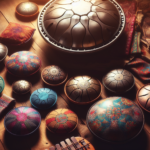The handpan, with its ethereal soundscapes and entrancing harmonics, has transcended its status from a mere musical instrument to a cultural phenomenon. Understanding the journey of the handpan not only illuminates its sonic allure but also unveils the intricate tapestry of innovation, artistry, and global cultural dynamics that shaped its rise. This article traces the evolution of the handpan from its conceptual inception to its revered status as a cultural icon.
The Birth of a Concept
In the late 20th century, the handpan as we know it did not exist. The seeds for its creation can be traced back to the steelpan, a traditional Caribbean instrument developed in Trinidad and Tobago. The steelpan’s unique tonal qualities and resonance inspired a new wave of instrument makers to experiment with sculpting sound from metal.
Swiss inventors Felix Rohner and Sabina Schärer were at the forefront of this exploration. By 2000, they had developed the first handpan, which they named the “Hang” (pronounced “hung”) derived from the Bernese German word for “hand.” The Hang was a novel instrument that combined principles of the steelpan with elements of gongs, gamelans, and other percussion instruments. The result was an instrument capable of producing melodic and rhythmic tones, each note imbued with a rich harmonic resonance.
Technical Marvel: Design and Construction
The handpan’s design is a marvel of acoustics and craftsmanship. It consists of two hemispherical shells of nitrided steel, glued together to form a single hollow vessel. On the upper shell, various dimples, called tone fields, are carefully hammered and tuned to produce specific notes. Each handpan is usually centered around a central note, or “Ding,” from which the rest of the tonal scale is derived.
The process of making a handpan is labor-intensive and requires precise engineering. The steel is carefully selected and treated to achieve the desired durability and sound quality. The tuning process is an art in itself, as each tone field must be meticulously shaped and harmonically balanced to produce the instrument’s characteristic ethereal sound.
Initial Reception and Cult Following
When the Hang was first introduced in the early 2000s, it captivated musicians and listeners alike. Its sound was unlike anything heard before, combining melodic and percussive elements in a single, visually striking instrument. The Hang’s unique sound and limited availability made it highly sought after, and it quickly garnered a cult following.
Rohner and Schärer crafted each Hang by hand, initially releasing only a limited number each year. This exclusivity, combined with the instrument’s mesmerizing qualities, contributed to its mystique. Musicians and enthusiasts worldwide sought after the Hang, and owning one became a symbol of prestige in the music community.
Expansion and Evolution
As the demand for the Hang grew, other makers around the world began developing their own versions of the handpan. Each maker brought unique techniques and innovations to the instrument, leading to a diversity of shapes, sizes, and sounds. The introduction of new makers also made the instrument more accessible to a broader audience.
Instruments such as the Pantheon Steel’s Halo, Meraki Instruments’ handpans, and the Innersound handpans emerged, each contributing to the growing tapestry of the handpan community. These variations allowed musicians to explore new sonic territories and push the boundaries of what was possible with the handpan.
The Handpan in Modern Music and Culture
By the 2010s, the handpan had solidified its presence in various musical genres and cultural contexts. Its distinctive sound became a staple in ambient, world, and meditative music, complementing everything from yoga sessions to film scores. Renowned musicians and performers began incorporating the handpan into their works, further elevating its status as a versatile and expressive instrument.
The handpan also became a symbol of cultural convergence. Its creation was influenced by a blend of traditions, and its rise to prominence reflected a global fascination with new and innovative sounds. The annual handpan gatherings and festivals worldwide became melting pots of cultural exchange, where musicians and enthusiasts could share their passion and experiences.
The Handpan Community
The rise of the handpan also gave birth to a vibrant and tightly-knit community. Online forums, social media groups, and handpan festivals became hubs for sharing knowledge, videos, and music. This sense of community and shared passion contributed significantly to the instrument’s continued evolution.
Organizations such as PANArt (the original makers of the Hang) and the Handpan Organization played pivotal roles in fostering and supporting this community. Through workshops, performances, and educational resources, they ensured that the art of handpan playing and making was passed down to new generations.
Cultural Impact and Symbolism
The handpan’s journey from a conceptual experiment to a cultural icon is a testament to its unique allure and the profound impact of music as a universal language. The instrument’s soothing, meditative tones resonate with individuals seeking tranquility and introspection, making it a powerful tool for personal and collective well-being.
Moreover, the handpan symbolizes the convergence of tradition and innovation. It draws from various cultural heritages while simultaneously pushing the boundaries of musical expression. This blend of old and new, local and global, underscores the instrument’s role as a symbol of our interconnected world.
Conclusion
The handpan’s journey from concept to cultural icon encapsulates a story of innovation, community, and cultural convergence. From its humble beginnings in the hands of passionate creators to its status as a sought-after instrument, the handpan continues to enchant and inspire musicians and listeners worldwide. Its ethereal sound and rich cultural tapestry ensure that it will remain a symbol of musical and artistic exploration for years to come.
FAQs
1. What is a handpan?
A handpan is a musical instrument consisting of two hemispherical shells of metal, typically steel, tuned to produce specific notes. It is played by striking the tone fields with the hands, producing a unique, melodic, and percussive sound.
2. How is a handpan different from a steelpan?
The handpan and the steelpan are both metal percussion instruments but differ in shape, sound, and playing technique. The handpan has a more resonant, melodic tone and is played with the hands, whereas the steelpan has a brighter tone and is typically played with mallets.
3. Who invented the handpan?
The handpan was invented by Swiss musicians Felix Rohner and Sabina Schärer in the early 2000s. They named their creation the “Hang,” which laid the foundation for the development of modern handpans.
4. Why are handpans so expensive?
Handpans are expensive due to the labor-intensive process of making and tuning the instrument. Each handpan is handcrafted, requiring skilled artisans to meticulously shape and fine-tune the metal to achieve the desired sound quality.
5. Can anyone learn to play the handpan?
Yes, anyone can learn to play the handpan. While it requires practice to master, the instrument’s intuitive layout and gentle sound make it accessible to beginners. Numerous online resources and tutorials are available to help new players get started.





